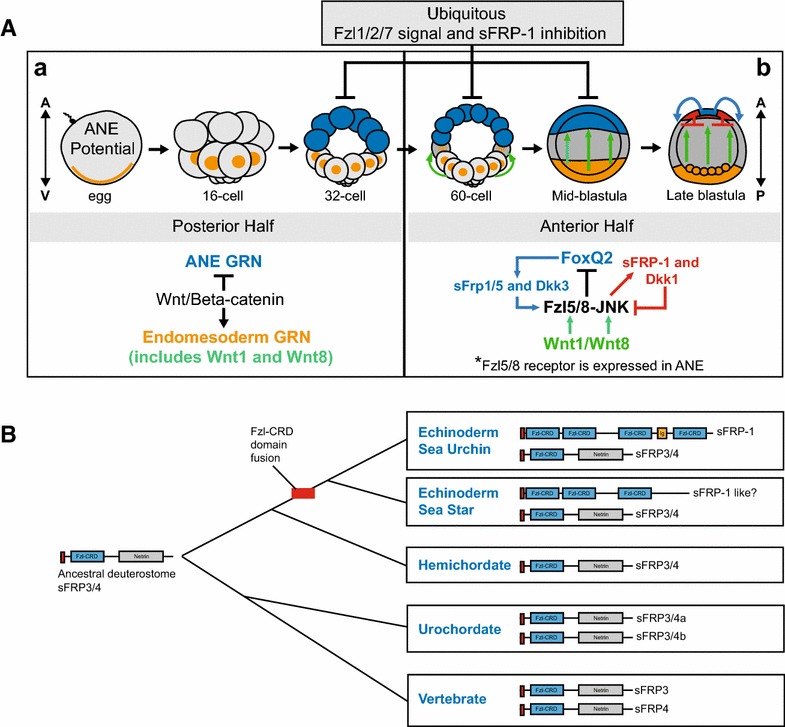Fig. 6.

A new model for the Wnt signaling network governing ANE restriction in the sea urchin embryo and the evolution of sFRP3/4 and sFRP-1 in deuterostomes. Aa Early downregulation of the ANE GRN from posterior blastomeres. (Posterior half of the embryo) A broad, maternal regulatory mechanism is able to activate the ANE GRN throughout the embryo by the 32-cell stage, but nβ-catenin signaling prevents the expression of the ANE GRN in the posterior half of the 32-cell embryo through an unknown mechanism and activates Wnt1 and Wnt8 expression at the 32-cell stage. In addition, around the 32- to 60-cell stage sFRP-1 and Fzl1/2/7 signaling antagonize the downregulation of the ANE GRN in the anterior hemisphere [20]. Ab Downregulation of the ANE GRN from cells in the lateral ectoderm domain and the establishment of the ANE around the anterior pole. (Anterior half of the embryo) Around the 32- to 60-cell stage (7–9 hpf), secreted Wnt1 and Wnt8 diffuse into more anterior ectodermal blastomeres (Wnt8 expression is activated throughout the equitorial ectoderm territory) and signal through the Fzl5/8 receptor, activating the JNK pathway. This Wnt/JNK pathway progressively downregulates ANE GRN expression from the central ectodermal territory during the early to late blastula stages (12–18 hpf). Within the same ectodermal cells, sFRP-1 and Fzl1/2/7 signaling antagonize Wnt1/Wnt8–Fzl5/8-JNK-mediated downregulation of the ANE GRN. Around the mid-blastula stage (16 hpf), an anterior signaling center activated by the cardinal ANE transcriptional regulator FoxQ2 secretes the Wnt modulators Dkk3 and sFRP-1/5 within the regressing ANE territory. Dkk3 and low levels of sFRP-1/5 are necessary to stimulate the Fzl5/8–JNK signaling during the later stages of ANE restriction. During the final phase of the process from early to late blastula stages (18–24 hpf), Fzl5/8 signaling activates the expression of the secreted Wnt antagonists sFRP-1 and Dkk1 in the anterior-most cells around the anterior pole. These antagonists establish a correctly sized ANE territory by preventing the downregulation of ANE factors by antagonizing Fzl5/8 signaling through a negative feedback mechanism [20]. B Schematic representation of the expansion of sFRP3/4 paralogues and sFRP-1 during deuterostome evolution
